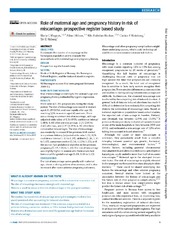Role of maternal age and pregnancy history in risk of miscarriage: prospective register based study
Magnus, Maria Christine; Wilcox, Allen J; Morken, Nils-Halvdan; Weinberg, Clarice R.; Håberg, Siri Eldevik
Peer reviewed, Journal article
Published version

Åpne
Permanent lenke
https://hdl.handle.net/1956/20280Utgivelsesdato
2019Metadata
Vis full innførselSamlinger
Originalversjon
https://doi.org/10.1136/bmj.l869Sammendrag
Objectives: To estimate the burden of miscarriage in the Norwegian population and to evaluate the associations with maternal age and pregnancy history. Design: Prospective register based study. Setting: Medical Birth Register of Norway, the Norwegian Patient Register, and the induced abortion register. Participants: All Norwegian women that were pregnant between 2009-13. Main outcome measure: Risk of miscarriage according to the woman’s age and pregnancy history estimated by logistic regression. Results: There were 421 201 pregnancies during the study period. The risk of miscarriage was lowest in women aged 25-29 (10%), and rose rapidly after age 30, reaching 53% in women aged 45 and over. There was a strong recurrence risk of miscarriage, with age adjusted odds ratios of 1.54 (95% confidence interval 1.48 to 1.60) after one miscarriage, 2.21 (2.03 to 2.41) after two, and 3.97 (3.29 to 4.78) after three consecutive miscarriages. The risk of miscarriage was modestly increased if the previous birth ended in a preterm delivery (adjusted odds ratio 1.22, 95% confidence interval 1.12 to 1.29), stillbirth (1.30, 1.11 to 1.53), caesarean section (1.16, 1.12 to 1.21), or if the woman had gestational diabetes in the previous pregnancy (1.19, 1.05 to 1.36). The risk of miscarriage was slightly higher in women who themselves had been small for gestational age (1.08, 1.04 to 1.13). Conclusions: The risk of miscarriage varies greatly with maternal age, shows a strong pattern of recurrence, and is also increased after some adverse pregnancy outcomes. Miscarriage and other pregnancy complications might share underlying causes, which could be biological conditions or unmeasured common risk factors.
